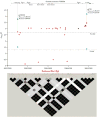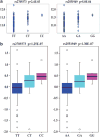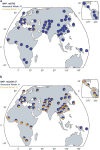Allelic differences between Europeans and Chinese for CREB1 SNPs and their implications in gene expression regulation, hippocampal structure and function, and bipolar disorder susceptibility
- PMID: 23568192
- PMCID: PMC3937299
- DOI: 10.1038/mp.2013.37
Allelic differences between Europeans and Chinese for CREB1 SNPs and their implications in gene expression regulation, hippocampal structure and function, and bipolar disorder susceptibility
Erratum in
- Mol Psychiatry. 2014 Apr;19(4):527
Abstract
Bipolar disorder (BD) is a polygenic disorder that shares substantial genetic risk factors with major depressive disorder (MDD). Genetic analyses have reported numerous BD susceptibility genes, while some variants, such as single-nucleotide polymorphisms (SNPs) in CACNA1C have been successfully replicated, many others have not and subsequently their effects on the intermediate phenotypes cannot be verified. Here, we studied the MDD-related gene CREB1 in a set of independent BD sample groups of European ancestry (a total of 64,888 subjects) and identified multiple SNPs significantly associated with BD (the most significant being SNP rs6785[A], P=6.32 × 10(-5), odds ratio (OR)=1.090). Risk SNPs were then subjected to further analyses in healthy Europeans for intermediate phenotypes of BD, including hippocampal volume, hippocampal function and cognitive performance. Our results showed that the risk SNPs were significantly associated with hippocampal volume and hippocampal function, with the risk alleles showing a decreased hippocampal volume and diminished activation of the left hippocampus, adding further evidence for their involvement in BD susceptibility. We also found the risk SNPs were strongly associated with CREB1 expression in lymphoblastoid cells (P<0.005) and the prefrontal cortex (P<1.0 × 10(-6)). Remarkably, population genetic analysis indicated that CREB1 displayed striking differences in allele frequencies between continental populations, and the risk alleles were completely absent in East Asian populations. We demonstrated that the regional prevalence of the CREB1 risk alleles in Europeans is likely caused by genetic hitchhiking due to natural selection acting on a nearby gene. Our results suggest that differential population histories due to natural selection on regional populations may lead to genetic heterogeneity of susceptibility to complex diseases, such as BD, and explain inconsistencies in detecting the genetic markers of these diseases among different ethnic populations.
Conflict of interest statement
The authors declare no conflict of interest.
Figures




References
-
- Zeng Z, Wang T, Li T, Li Y, Chen P, Zhao Q, et al. Common SNPs and haplotypes in DGKH are associated with bipolar disorder and schizophrenia in the Chinese Han population. Mol Psychiatry. 2010;16:473–475. - PubMed
-
- McGuffin P, Rijsdijk F, Andrew M, Sham P, Katz R, Cardno A. The heritability of bipolar affective disorder and the genetic relationship to unipolar depression. Arch Gen Psychiatry. 2003;60:497–502. - PubMed
Publication types
MeSH terms
Substances
Grants and funding
LinkOut - more resources
Full Text Sources
Other Literature Sources
Medical

